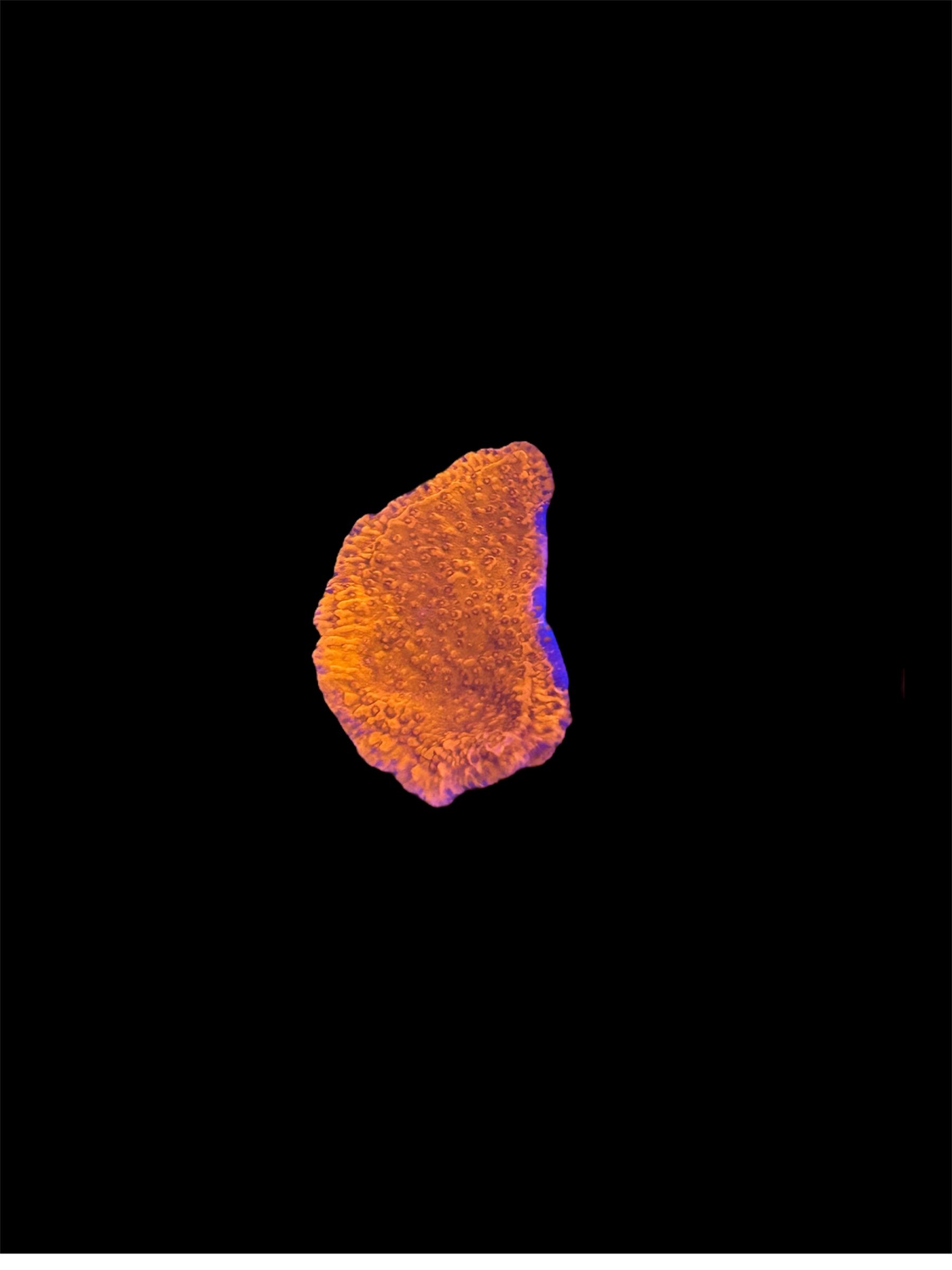RED PLATING MONTI FRAG
Montipora corals are a type of SPS (Small Polyp Stony) coral. They are prized for their vibrant colors and unique growth patterns (e.g., plating, branching, encrusting). They are moderately hardy but require stable water conditions.
Care Guide
1. Placement
• Lighting: High to moderate light. Use LED, T5, or metal halide lights. Aim for PAR levels of 200-400.
• Flow: Moderate to strong, with random flow patterns to avoid detritus buildup.
• Position: Place in the upper to mid-levels of your tank, depending on light intensity. Acclimate them to light to avoid bleaching.
2. Water Parameters
• Temperature: 75–80°F (24–27°C)
• Salinity: 1.025–1.026 specific gravity
• Alkalinity: 8–12 dKH
• Calcium: 400–450 ppm
• Magnesium: 1250–1350 ppm
• Nitrates: 1–5 ppm
• Phosphates: 0.01–0.03 ppm
• Keep parameters stable to avoid stress or tissue loss.
3. Feeding
• Primarily photosynthetic, but benefits from supplemental feedings.
• Feed with:
• Phytoplankton or zooplankton.
• Powdered coral foods like Reef-Roids or Coral Frenzy (1–2 times per week).
4. Growth & Maintenance
• Growth Rate: Moderate to fast, depending on water quality and stability.
• Fragging: Use bone cutters or a Dremel for clean cuts. Ensure stable mounting on plugs or rock.
5. Pests & Problems
• Watch for:
• Montipora-eating nudibranchs: Inspect frags regularly.
• Algae overgrowth: Maintain proper flow and keep nutrients in check.
• Quarantine new frags to prevent pest introduction.
6. Compatibility
• Safe with most reef inhabitants. Avoid placing near aggressive corals (like Euphyllia) to prevent stinging.
Montipora corals are a type of SPS (Small Polyp Stony) coral. They are prized for their vibrant colors and unique growth patterns (e.g., plating, branching, encrusting). They are moderately hardy but require stable water conditions.
Care Guide
1. Placement
• Lighting: High to moderate light. Use LED, T5, or metal halide lights. Aim for PAR levels of 200-400.
• Flow: Moderate to strong, with random flow patterns to avoid detritus buildup.
• Position: Place in the upper to mid-levels of your tank, depending on light intensity. Acclimate them to light to avoid bleaching.
2. Water Parameters
• Temperature: 75–80°F (24–27°C)
• Salinity: 1.025–1.026 specific gravity
• Alkalinity: 8–12 dKH
• Calcium: 400–450 ppm
• Magnesium: 1250–1350 ppm
• Nitrates: 1–5 ppm
• Phosphates: 0.01–0.03 ppm
• Keep parameters stable to avoid stress or tissue loss.
3. Feeding
• Primarily photosynthetic, but benefits from supplemental feedings.
• Feed with:
• Phytoplankton or zooplankton.
• Powdered coral foods like Reef-Roids or Coral Frenzy (1–2 times per week).
4. Growth & Maintenance
• Growth Rate: Moderate to fast, depending on water quality and stability.
• Fragging: Use bone cutters or a Dremel for clean cuts. Ensure stable mounting on plugs or rock.
5. Pests & Problems
• Watch for:
• Montipora-eating nudibranchs: Inspect frags regularly.
• Algae overgrowth: Maintain proper flow and keep nutrients in check.
• Quarantine new frags to prevent pest introduction.
6. Compatibility
• Safe with most reef inhabitants. Avoid placing near aggressive corals (like Euphyllia) to prevent stinging.
Montipora corals are a type of SPS (Small Polyp Stony) coral. They are prized for their vibrant colors and unique growth patterns (e.g., plating, branching, encrusting). They are moderately hardy but require stable water conditions.
Care Guide
1. Placement
• Lighting: High to moderate light. Use LED, T5, or metal halide lights. Aim for PAR levels of 200-400.
• Flow: Moderate to strong, with random flow patterns to avoid detritus buildup.
• Position: Place in the upper to mid-levels of your tank, depending on light intensity. Acclimate them to light to avoid bleaching.
2. Water Parameters
• Temperature: 75–80°F (24–27°C)
• Salinity: 1.025–1.026 specific gravity
• Alkalinity: 8–12 dKH
• Calcium: 400–450 ppm
• Magnesium: 1250–1350 ppm
• Nitrates: 1–5 ppm
• Phosphates: 0.01–0.03 ppm
• Keep parameters stable to avoid stress or tissue loss.
3. Feeding
• Primarily photosynthetic, but benefits from supplemental feedings.
• Feed with:
• Phytoplankton or zooplankton.
• Powdered coral foods like Reef-Roids or Coral Frenzy (1–2 times per week).
4. Growth & Maintenance
• Growth Rate: Moderate to fast, depending on water quality and stability.
• Fragging: Use bone cutters or a Dremel for clean cuts. Ensure stable mounting on plugs or rock.
5. Pests & Problems
• Watch for:
• Montipora-eating nudibranchs: Inspect frags regularly.
• Algae overgrowth: Maintain proper flow and keep nutrients in check.
• Quarantine new frags to prevent pest introduction.
6. Compatibility
• Safe with most reef inhabitants. Avoid placing near aggressive corals (like Euphyllia) to prevent stinging.

